Manchester United’s poor start to the season has left them sitting in 13th place with just seven points from six matches.
A deeper look into their tactical approach reveals that they’ve only scored five goals, the second-lowest in the Premier League, with only Southampton scoring fewer with three.
This tactical analysis will explore the root of their attacking inefficiencies and use statistics to uncover what’s wrong with their finishing this season.
Our scout report and analysis will break down the team’s current tactics and assess why Erik Ten Hag’s Manchester United are struggling to create and convert chances in 2024/25.
When Did Manchester United’s Issues Start?
Manchester United last won the Premier League in the 2012/2013 season, scoring 86 goals.
This appears to have been Manchester United’s last truly great season, which, of course, was also Sir Alex Ferguson’s last season.

Although they’ve had seasons where they recently finished second and third, 2012/2013 was the last time they were a ruthless team with the hunger to fight for the title and dominate opponents.
Ever since that campaign, it’s seemed that United has lost its attacking edge, with its goalscoring in the Premier League progressively getting worse.
Manchester United have arguably spent most of their money on attackers since then and on some big names, which we will cover later, but one thing is clear: United have never returned to those peak levels from 2012/2013.
Manchester United have had five managerial changes, with three interim/caretaker managers, for a total of eight personnel changes since Sir Alex Ferguson left the club.
Despite this, nobody has been able to fully save United as they continue to decline.
We’re not going to pretend that we know exactly what United can do to fix their attacking issues or claim to have inside knowledge of what happens in the dressing room (especially with those internal problems), but rather focus on the challenges they’ve faced this season and provide transparency regarding their attacking output so far.
If five managers and three caretakers cannot resolve the issue, it will take a lot of effort to help United get out of the mess it’s been in over the past few years.
Manchester United Failed Attacking Transfers
Manchester United have invested heavily in their attacking options over recent years.
Looking at recent years, Joshua Zirkzee was the most recent attacker, signed for £36m.
Before him were Antony, who was signed for £80m,
Jadon Sancho for £76.5m, and Rasmus Højlund, who was added fora hefty £64.7m.
Anthony Martial joined the club for £54m, and Amad Diallo, initially costing £19m, could rise to £37m with bonuses.
Facundo Pellistri was signed for £9m, while the legendary Cristiano Ronaldo returned to the club for £13.5m.
Past attackers include Memphis Depay, who was brought in for £30.6m, and Romelu Lukaku, who cost £76m.
Angel Di Maria was signed for £67.5m, and Radamel Falcao arrived on a loan deal for £6.8m.
The club also acquired Zlatan Ibrahimović and Edinson Cavani on free transfers, though likely contributed significantly to the club’s wage bill during their time, and Odion Ighalo had a loan deal worth £10.5m.
Thus, the total investment in these attackers amounts to £544.1m in transfer fees, not including wages.
Erik Ten Hag Tactics & Philosophy
Erik ten Hag’s tactical philosophy revolves around aggressive pressing and dynamic attacking play with constant rotations.
His teams often rely on width and crosses supplied by the full-backs, while the build-up is rotated between a single or double pivot.
Erik Ten Hag’s formation employs a versatile tactical shape.
To adapt to different situations on the pitch, it frequently alternates between a 4-4-2 diamond, 4-3-3, or 4-2-3-1 formation.
He has been trying to implement this at Manchester United, but some may argue that his tactical ideals aren’t visible.
Manchester United Statistics For Premier League 2024/25
Manchester United Shots Map
When looking at the Manchester United shot map, we can see to what extent they are underperforming their xG.
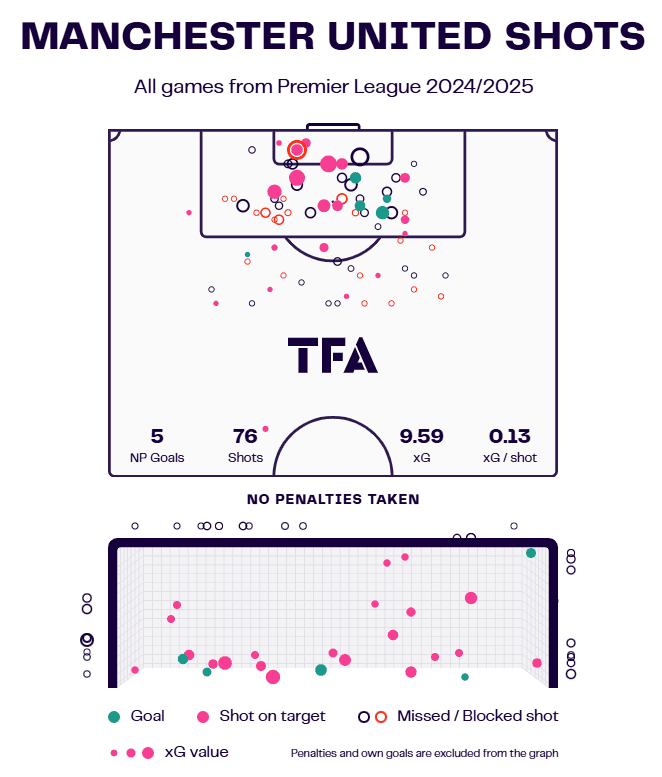
With 9.59 xG and only five goals, the club’s attackers are missing good chances to find the back of the net.
An xG of 0.13 per shot also indicates that many of the chances being taken are not high quality and are simply being hit for the sake of shooting.
If United can resolve their xG issues, they could easily win more of their matches, which are currently being impacted by poor attacking output.
Manchester United Shot Assists Map
The shot assist map supports the shot map above, showing that the team is underperforming in converting chances into goals compared to its opportunities.
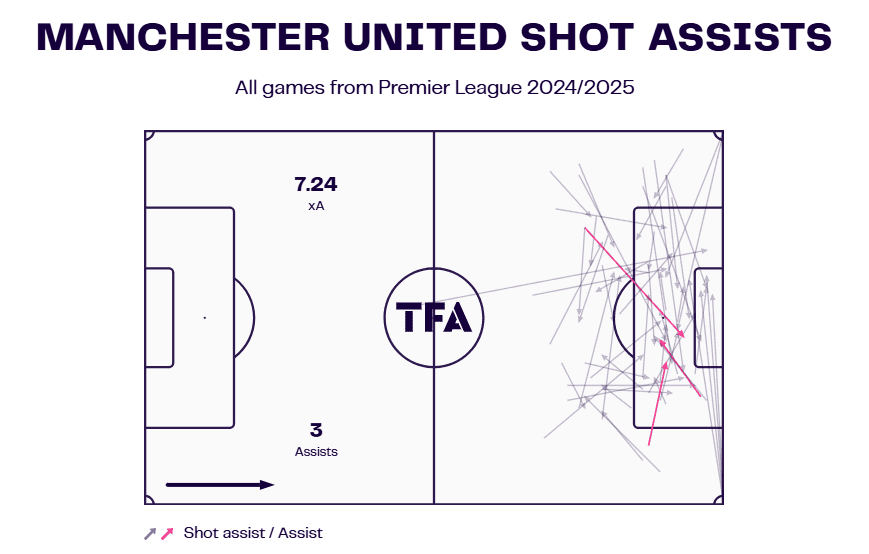
This map points to the same conclusion: the xA is 7.24, yet they only have three assists.
This means that the final pass into the final third is being placed well, but the finishing is not there to complete the action.
Manchester United Penetrating Carries Map
The penetrating carries map leads to the same conclusion.
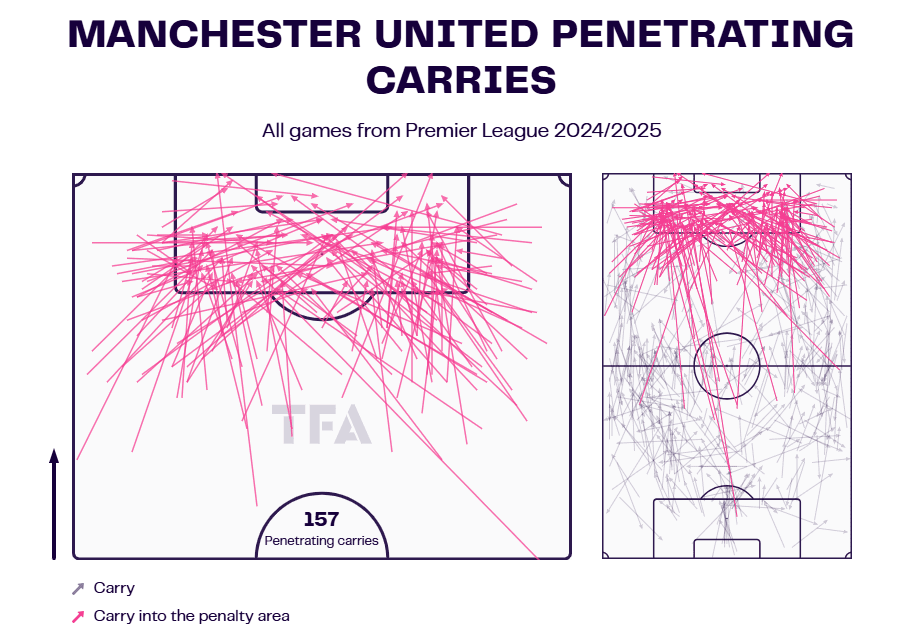
For reference, Chelsea have 128 penetrating carries and the most goals in the Premier League with 15.
Yet, a team like Manchester United, with 157 penetrating carries, have the second-fewest goals.
What do the shot map, assist map, and this penetration carries map mean?
It’s simple: the strikers are not putting their chances away.
Penetrating the box 157 times and only scoring five goals is incredibly underwhelming.
Getting into the final third and penetrating the box often shows that the tactical setup to get United into that stage of the field is working well, but something is going wrong at the final hurdle.
Manchester United Crossing Zones Map
Manchester United’s cross-completion rates are quite low for a team that loves including the full-backs in play and pushing them up the field to help create overloads and chances in the final third.
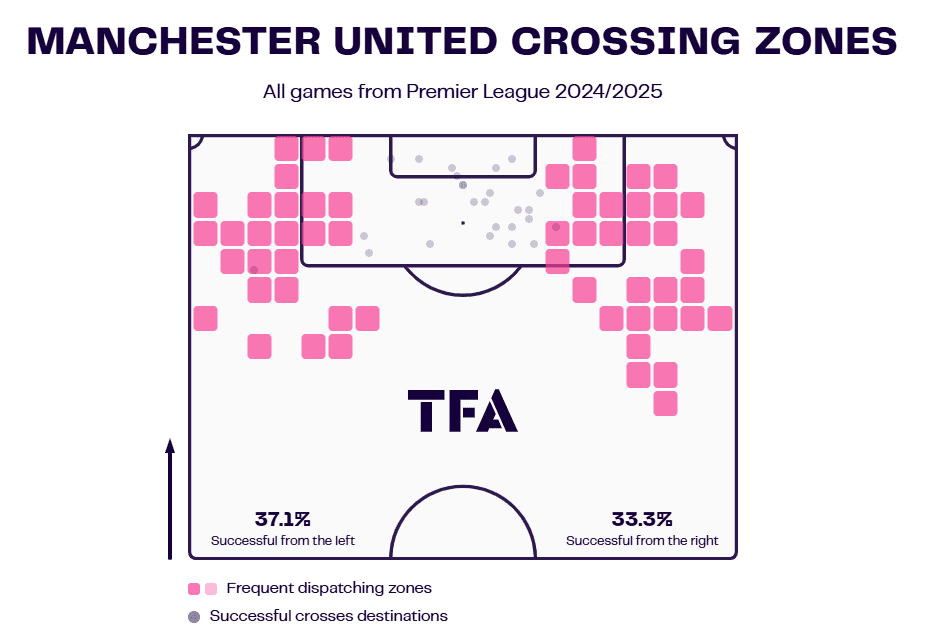
For reference, Arne Slot, another Dutchman, has implemented a system where his team achieves roughly a 40% completion rate for crosses in key zones on both sides of the pitch.
Crosses can be incredibly dangerous in the Premier League, especially with teams dedicating many training sessions to practising set-pieces, corners, or simple crosses into the box.
Arsenal, arguably the best team in England, and possibly the world, at set-pieces, shows how crucial this aspect can be.
Yet, it seems as though United don’t place much focus on this element of their game.
Man Utd Vs Tottenham Analysis – Matchday 6
Many people blamed Erik ten Hag for Man United’s big loss against Tottenham, which saw them overrun 3-0.
However, they failed to see United’s chances to level the score before going down to 10 men.
A manager’s job is to help with ball progression, progress the team to the final third, and provide as much assistance as possible once they get there.
However, they can’t walk onto the pitch, freeze the play, and tell the players what to do in real-time.
The final third is purely instinctual—players have 1-3 seconds to make a decision, and it has to be the right one to create a goal-scoring opportunity.
United are getting into those positions but can’t finish their chances.
Missed Opportunity #1
The first clear-cut chance for United came from this opportunity, where Zirkzee had the chance to put the ball in the back of the net as the goal was wide open from the centre of the posts.
However, he couldn’t get his footing right and scuffed the opportunity to level the game.
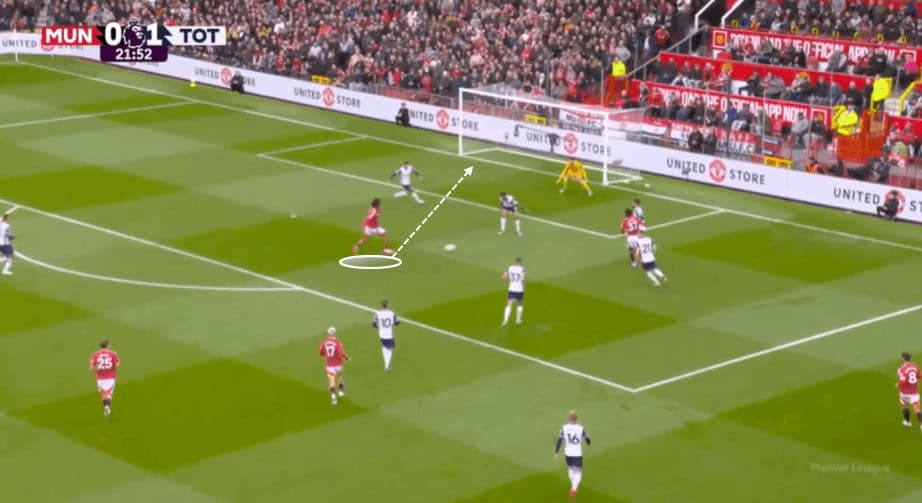
Missed Opportunity #2
The second chance they had was from Garnacho.
This chance was difficult to convert, but considering the ball hit the side netting for a goal kick, it could have been better.
Putting the ball on target could have created a rebound opportunity for another player, or who knows, it might have slipped into the net by deflection.
Once again, it was another clear chance to level the game.
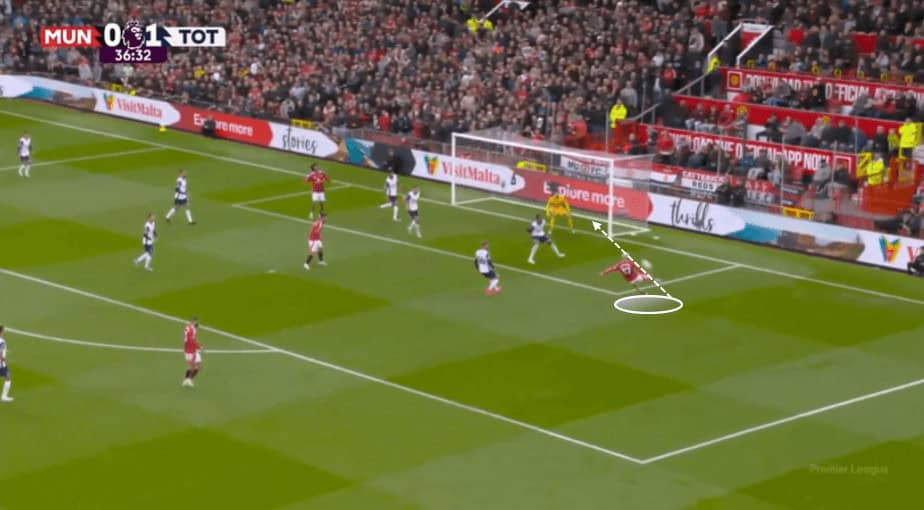
These are just two chances of the many times this has happened.
We’ve decided to highlight that very much could have been goals and accumulated a lot of xG.
When looking at United matches, the general media always says, “That should have gone in,” or “If he scored that, the game would be different.”
It’s tough to blame the manager for his players not finishing their chances.
However, where the manager can be blamed for choosing to bring those players to the club, which will be talked about below.
Erik Ten Hag Attacking Style Of Play
United’s attacking style has remained consistent under Erik ten Hag’s style of play, and perhaps that’s why their attacking output hasn’t improved.
It has consistently involved two midfielders dropping deep into the number 10 role, with a front three consisting of two wingers and a lone striker.
Maybe it’s time to try a dual-striker partnership or involve more players in penetrating the opposition box to help create overloads and more chances for players to finish their opportunities.
As mentioned before, getting to the box has never been an issue—it’s finishing in the box that has.
The dynamic of their offence could improve with more players involved in the attacking play or a change in the starting attackers.
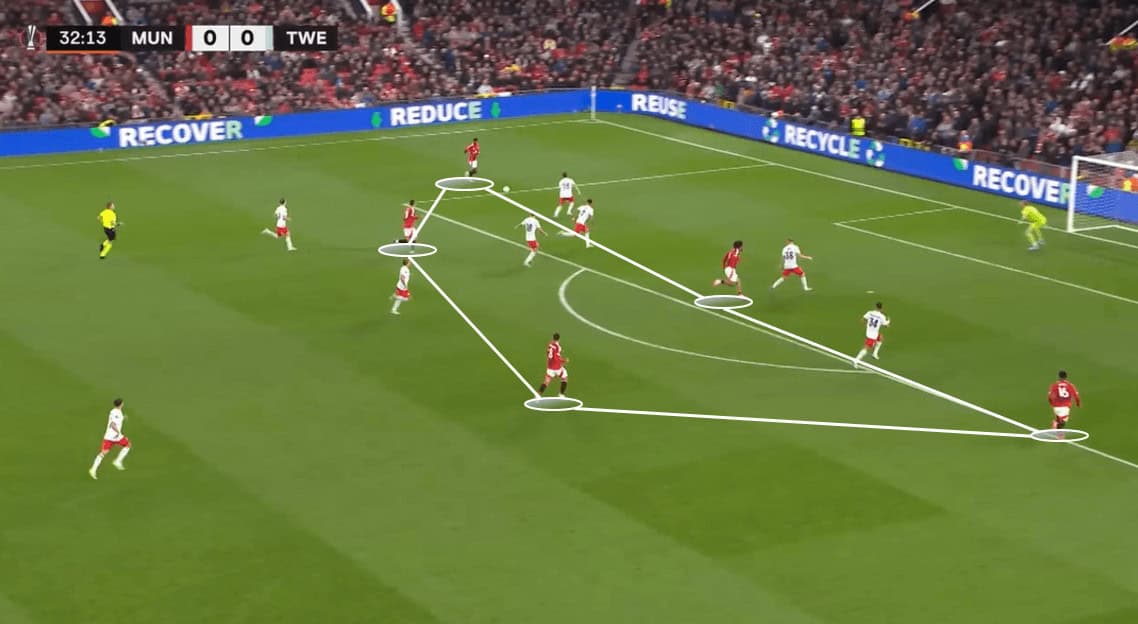
Manchester United’s Mistakes In Profiling
A common issue at United has been their player profiling.
They often buy sought-after and talented players, but they buy them for the sake of buying rather than fitting them into a system or philosophy.
This is the exact opposite philosophy compared to their Merseyside rivals, Liverpool, who buy up-and-coming players who specifically fit into their coach’s system and eventually become superstars like Mohamed Salah and Virgil Van Dijk.
Sometimes, it seems that United buy players to keep them from other teams, rather than focusing on how they fit in at Old Trafford.
The most prominent example is the purchase of Paul Pogba, who thrived as a number 8 or higher in a number 10 role.
But once United bought him and started using him as a pivot in the number 6 position, his career began to decline.
More recent examples include the purchases of Højlund and Zirkzee.
Højlund, for one, never had that standout breakthrough season in Italy to warrant such an expensive move to be United’s main striker.
For a team looking for immediate results, it might have made more sense to cash in on someone like Ivan Toney or Victor Osimhen, who could deliver instant impact.
Another example is Zirkzee, who had a great season at Bologna but didn’t play as a traditional solo number 9.
He thrived in a free-roaming role, dropping deep to help link-up play and starting counterattacks.
However, United bought him and are now using him as a solo striker, which is not how he typically operates or excels.
One of United’s biggest issues has certainly been its player profiling and the recruitment of the wrong players.
Bringing in good players and hoping they will work well together isn’t an effective strategy, and this has been a problem at United ever since Sir Alex Ferguson left the club.
Conclusion
In conclusion, Manchester United’s struggles this season can be traced back to deeper issues that have been present since Sir Alex Ferguson’s departure.
Despite significant investments in attacking talent, the club has failed to properly profile players to fit into a cohesive system, resulting in underperformance in front of goal.
While their tactical structure allows them to reach the final third consistently, their finishing and decision-making in crucial moments have let them down.
Additionally, their continuous reliance on their one-dimensional attacking formation in a 4-3-3 and the lack of player changes up top to create a new dynamic have further hindered their ability to evolve.
Suppose Manchester United is to return to the heights of the 2012/2013 season. In that case, they need a more coherent vision in player recruitment, tactical adjustments, and a greater emphasis on finding solutions in the final third.
Only then can they start to overcome the challenges that have plagued them for years.

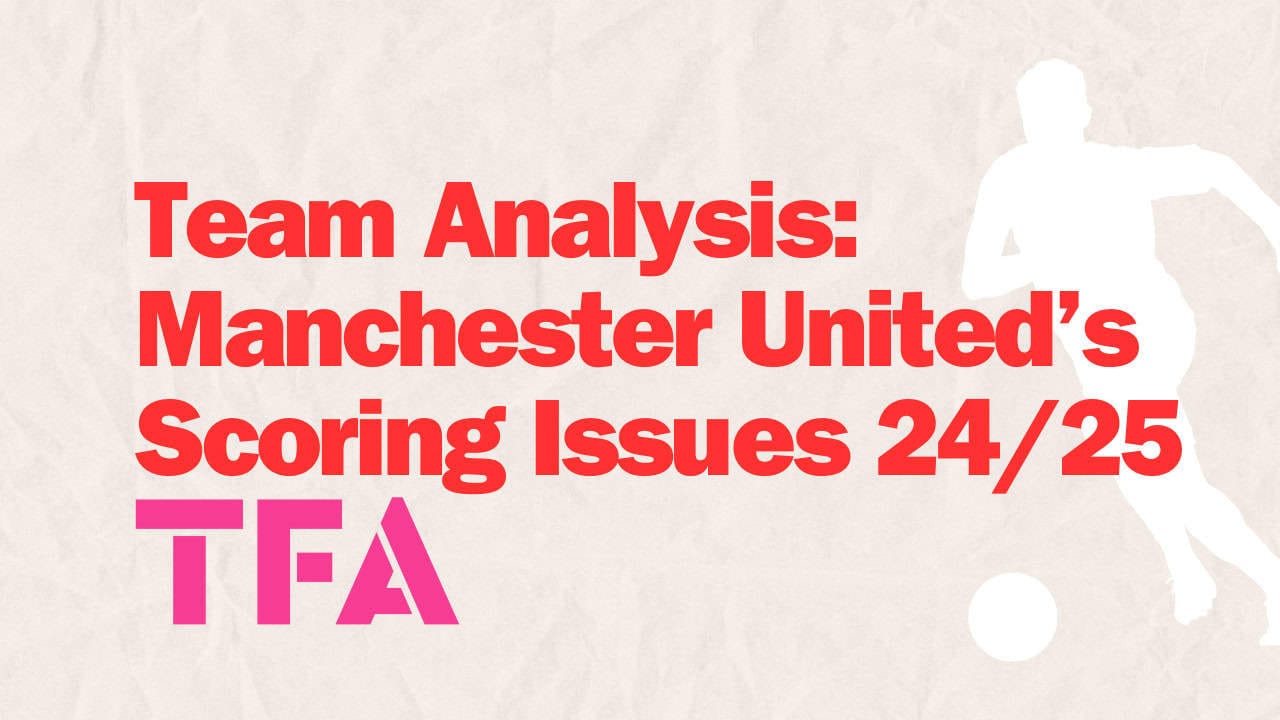



Comments